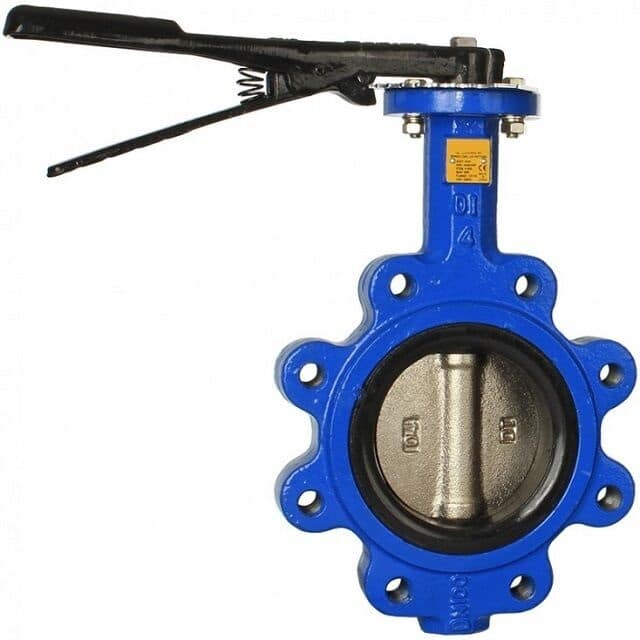Butterfly valves are essential components in many flow control systems, providing efficient regulation of various fluids and gases. These valves are favored for their compact design, cost-effectiveness, and versatility across different applications. This article looks into the fundamental aspects of butterfly valves, exploring their types, features, benefits, applications, and more.
What Are Butterfly Valves?
Butterfly valves are rotational valves that operate with a quarter-turn mechanism to manage or shut off the flow of fluid in a pipeline. They feature a circular disc or vane that pivots to regulate the flow. This disc is attached to a shaft and can be rotated by an actuator, enabling the valve to either open or close. When the disc aligns with the pipe, the valve is in the open position, permitting fluid flow. Conversely, when the disc is positioned vertical to the pipe, the valve is closed, blocking the flow.
The key components of a butterfly valve include:
- Disc: The circular plate that rotates to regulate flow.
- Seat: The sealing surface against which the disc closes.
- Stem: The rod that connects the disc to the actuator.
- Actuator: The mechanism (manual lever, electric motor, pneumatic actuator) that turns the stem and disc.
Types of Butterfly Valves
Butterfly valves come in several varieties, each designed to meet specific needs and applications. Understanding these types can help in selecting the right valve for a given application.
Concentric Butterfly Valves
Concentric butterfly valves, also known as centric or single-offset valves, have their disc and stem aligned with the centerline of the valve body. They are typically used in low-pressure applications and offer a simple design with fewer components. The concentric design makes them cost-effective and easy to maintain.
Ideal for water and air applications, concentric butterfly valves provide reliable performance in systems where pressure and temperature variations are minimal.
Double Offset (Lug) Butterfly Valves
Double offset butterfly valves have two key offsets: the disc is shifted from the valve’s centerline, and the stem is positioned offset from the disc. This configuration minimizes friction and wear on the seat, making the valve well-suited for applications involving high pressure and temperature.
Commonly used in chemical processing and steam systems, double offset valves provide a tight seal and enhanced durability compared to concentric valves.
Triple Offset Butterfly Valves
Triple offset butterfly valves, also known as triple-eccentric valves, have three key offsets: the stem, disc, and seat are all offset from each other. This design allows for precise control and a bubble-tight seal.
These valves are suited for high-performance applications, including those with extreme temperatures and pressures. They are commonly used in oil and gas industries and in applications where leakage prevention is critical.
High-Performance Butterfly Valves
High-performance butterfly valves are designed for demanding applications, featuring advanced materials and construction techniques. They often incorporate a combination of double or triple offsets, and may include additional features like high-strength actuators and specialized coatings.
Ideal for industries requiring robust performance under severe conditions, such as chemical processing and power generation.
Order your high-quality butterfly valves here: https://valveman.com/valves/butterfly-valves/
Key Features and Benefits
Butterfly valves offer several advantages that make them suitable for a wide range of applications.
Flow Control Efficiency
Butterfly valves excel at regulating flow due to their quarter-turn operation, which allows for precise adjustment of the flow rate. Their design provides a straight-through flow path, minimizing pressure loss and turbulence compared to other valve types.
Comparison with Other Valves: Unlike globe valves, which offer finer control but with higher pressure drop, butterfly valves provide a more streamlined and cost-effective solution for many flow control needs.
Space and Weight Considerations
One of the standout features of butterfly valves is their compact design. They occupy less space and weigh less than traditional gate or globe valves, making them ideal for installations with limited space.
Benefits in Space-Constrained Applications: The reduced footprint and weight can lead to cost savings in terms of installation and support structures.
Cost-Effectiveness
Butterfly valves are generally more affordable than many other valve types due to their simpler construction and manufacturing processes. This cost advantage extends to maintenance as well, as butterfly valves typically have fewer moving parts and are easier to service.
Initial Cost vs. Long-Term Maintenance Costs: While the initial investment is lower, the long-term maintenance costs are also reduced due to the valve’s robust design and fewer components.
Versatility and Range of Applications
Butterfly valves are highly versatile and can be used in a wide range of industries and applications. Their ability to handle various types of fluids and gases, including corrosive and high-purity substances, adds to their appeal.
Use in Various Industries: From water treatment and HVAC systems to chemical processing and oil and gas, butterfly valves offer flexibility and reliability across different sectors.
Installation and Operation
Proper installation and operation are crucial for the effective performance of butterfly valves.
When installing butterfly valves, it is important to ensure proper alignment and mounting. The valve should be installed with the disc in the fully open position to avoid stress on the seat and stem. Proper sealing and alignment prevent leaks and ensure optimal performance.
Butterfly valves can be operated manually or automated using various actuators. Manual valves use a handwheel or lever, while automated valves use electric, pneumatic, or hydraulic actuators. Adjusting the valve correctly is essential for achieving the desired flow control and system efficiency.
Conclusion
Butterfly valves are integral components in flow control systems, offering a combination of efficiency, cost-effectiveness, and versatility. Their diverse applications across different industries underscore their importance in managing fluid and gas flow. Understanding the various types, features, and maintenance requirements of butterfly valves helps in selecting the right valve for specific needs and ensuring optimal performance.



